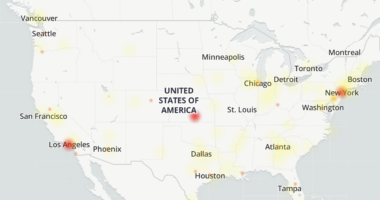NASA’S James Webb Space Telescope has captured a stunning new image of one of the most recognisable objects in the night sky.
Over the weekend, the $10billion orbiting probe captured the inner region of the Orion Nebula in all of its glory.
Sitting around 1,300 light-years from Earth, the enormous dust cloud stretches 30 to 40 light-years across.
The new images from James Webb – the most advanced telescope ever built – show more of the famed nebula than ever seen before.
And it’s hiding a big secret – hidden within it are newborn stars wrapped in cocoons of dust and gas.
“We are blown away by the breathtaking images of the Orion Nebula,” Els Peeters, an astrophysicist at Ontario’s Western University and one of JWST’s Canadian collaborators, said.


“We started this project in 2017, so we have been waiting more than five years to get these data.”
One of the most photographed objects in the sky, the Orion Nebula is a huge cloud of gas and dust – one of many in the known universe.
The cocoon of matter gives birth to stars and has revealed much about the process of how stars and planetary systems are formed.
While scientists have been studying the nebula for decades, James Webb offers a chance to see it in new light.
Most read in Tech
The images, published on September 11, show stars in various stages of development with greater clarity than ever before.
They also give a more detailed look at the “filaments” and gas clouds that astronomers believe are the birthplace of stars.
Scientists hope to use James Webb observations to dig deeper into star formation and ultimately how our universe came to be.
“These new observations allow us to better understand how massive stars transform the gas and dust cloud in which they are born,” said Peeters.
“Massive young stars emit large quantities of ultraviolet radiation directly into the native cloud that still surrounds them, and this changes the physical shape of the cloud as well as its chemical makeup.
“How precisely this works, and how it affects further star and planet formation is not yet well known.”
Nasa released the first images of our universe from James Webb, which is about half the size of a 747 aircraft, in July.
Since then, the telescope has captured stunning snaps of supernovae, exoplanets, and Jupiter’s northern and southern lights.
James Webb, which was built with the help of the European Space Agency, can see deeper into space than any telescope before it.


That allows it to effectively peer back in time by viewing light that has taken billions of years to reach our planet.
Scientists hope that these observations will expand our understanding of the early universe.
Find out more about science
Want to know more about the weird and wonderful world of science? From the Moon to the human body, we have you covered…
We pay for your stories! Do you have a story for The Sun Online Tech & Science team? Email us at [email protected]
This post first appeared on Thesun.co.uk










